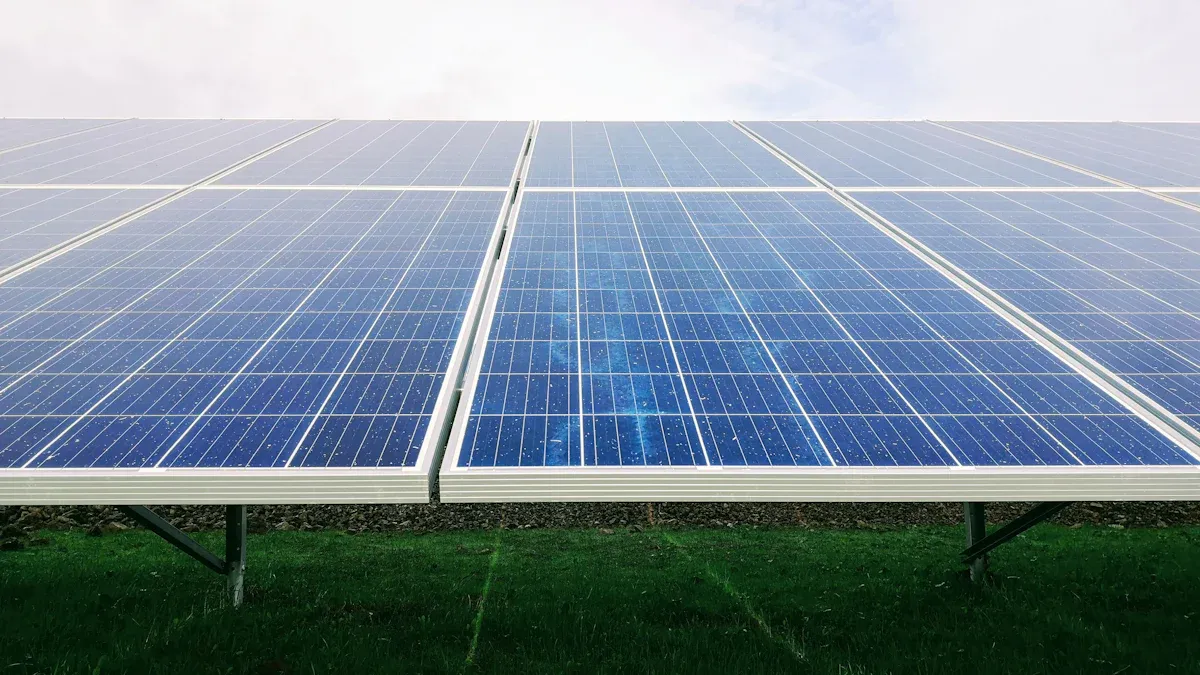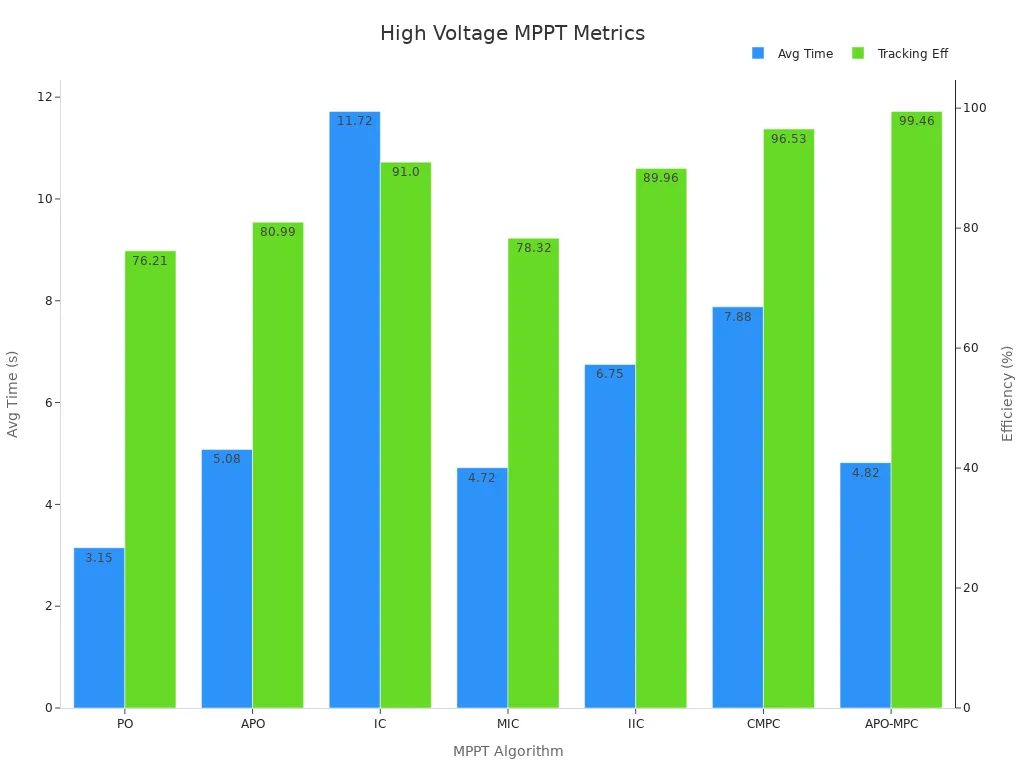Optimizing Solar Arrays: How MPPT Handles High Voltage Panels

Optimizing solar arrays for maximum energy output requires advanced technology. MPPT, or Maximum Power Point Tracking, plays a crucial role in ensuring your solar panels operate at their peak efficiency. By continuously adjusting the voltage and current, MPPT extracts the highest possible energy from your system. For instance, studies reveal that MPPT controllers can achieve up to 99.79% tracking efficiency, significantly outperforming traditional methods.
High voltage panels benefit immensely from MPPT. A comparison shows that a 420W panel paired with MPPT delivers nearly 420W, while a conventional controller limits the output to just 162.6W. This boost not only enhances energy yield but also ensures efficient utilization of your solar arrays, making MPPT indispensable for modern solar systems.
Key Takeaways
MPPT technology helps solar panels make the most energy possible.
It adjusts voltage and current to keep panels working well.
High voltage panels with MPPT give more energy than older systems.
MPPT controllers protect parts, making solar systems last longer.
They check weather changes and keep panels working their best.
Picking the right MPPT controller helps high voltage panels work better.
How MPPT Optimizes Solar Arrays

The principles of Maximum Power Point Tracking
Maximum Power Point Tracking (MPPT) is a technique that ensures your solar panels operate at their highest efficiency by continuously adjusting the voltage and current. This process is based on the maximum power transfer theorem, which states that maximum power can only be extracted when the load resistance matches the internal resistance of the power source.
The maximum power point tracking (MPPT) technique is based on the maximum power transfer theorem, which states that maximum power can only be extracted when the load resistance matches the internal resistance of the power source.
In photovoltaic systems, this principle becomes essential because the resistance of solar panels changes with environmental factors like sunlight intensity and temperature. MPPT dynamically adapts to these changes, ensuring your solar power system consistently delivers the highest possible power output.
A study using advanced modeling and simulation techniques, such as the Levenberg-Marquardt method, confirms the effectiveness of MPPT strategies. It highlights how MPPT optimizes energy output even under challenging conditions like shading, which can significantly reduce power generation. This makes MPPT an essential component of any solar power system, enabling you to unlock the full potential of your solar system.
Concept | Explanation |
|---|---|
Characteristic Resistance | The load resistance must equal the reciprocal of the maximum power point to draw maximum power. |
Dynamic Quantity | This resistance changes with illumination, temperature, and cell condition. |
Power Output | Deviations from this resistance reduce power output. |
MPPT as a DC-DC converter for voltage optimization
MPPT controllers act as DC-DC converters, optimizing voltage to ensure efficient energy transfer from your solar panels to the battery or inverter. This process involves stepping up or stepping down the voltage to match the requirements of the connected load, maximizing energy yield.
Benefit | Description |
|---|---|
Efficiency | The converter achieves high efficiency of 95%. |
Voltage Gain | It provides a considerable gain, up to 12 times higher than the input voltage. |
Reduced Electrical Stress | The voltage stress on diodes is significantly lower, almost one-fifth of the output voltage. |
Common Grounding | The design includes a common grounding feature to prevent electromagnetic interference. |
Continuous Input Current | Ensures a steady input current, extending the life of the PV system. |
By maintaining a steady input current and reducing electrical stress, MPPT controllers enhance the reliability and lifespan of your solar power system. This voltage optimization not only improves efficiency but also ensures that your photovoltaic systems operate seamlessly, even under fluctuating conditions.
Adapting to environmental changes for peak performance
Environmental factors like sunlight intensity and temperature can vary throughout the day, directly impacting the performance of your solar panels. MPPT continuously monitors these conditions and adjusts the operating point of your inverter in real time. This adaptability ensures that your solar panels always operate at their maximum power point, maximizing energy production.
MPPT continuously monitors environmental conditions, allowing for real-time adjustments to the inverter's operating point.
It maximizes energy production by ensuring solar panels operate at their maximum power point (MPP) despite changes in sunlight intensity and temperature.
The algorithm's adaptability to changing conditions leads to increased energy harvest and improved overall system performance.
This ability to adapt to changing conditions is what makes MPPT a cornerstone of solar energy harvesting. Whether it's a cloudy day or a sudden drop in temperature, MPPT ensures your solar power system delivers consistent performance and energy output.
MPPT Charge Controller and High Voltage Panels

Managing high voltage inputs with MPPT
Handling high voltage inputs effectively is one of the standout features of an mppt charge controller. High voltage solar panels often produce energy levels that fluctuate due to environmental factors like sunlight intensity. Without proper management, these fluctuations can lead to energy losses or even damage to your system. MPPT technology ensures that your solar panels operate safely and efficiently by dynamically adjusting the voltage to match the system's requirements.
The effectiveness of MPPT in managing high voltage inputs can be seen in its advanced algorithms. For instance, the APO-MPC algorithm achieves a remarkable tracking efficiency of 99.46%, outperforming other methods. This high efficiency ensures that your solar system captures and utilizes the maximum possible energy. Below is a comparison of various MPPT algorithms based on their computational time and tracking efficiency:
MPPT Algorithm | Average Computational Time (s) | Tracking Efficiency (%) |
|---|---|---|
PO | 3.15 | 76.21 |
APO | 5.08 | 80.99 |
IC | 11.72 | 91.00 |
MIC | 4.72 | 78.32 |
IIC | 6.75 | 89.96 |
CMPC | 7.88 | 96.53 |
APO-MPC | 4.82 | 99.46 |

By leveraging these advanced algorithms, MPPT controllers ensure that high voltage inputs are managed efficiently, maximizing energy output while protecting your solar system from potential damage.
Voltage matching for optimal energy transfer
Voltage matching is critical for achieving optimal energy transfer in solar systems. An mppt charge controller excels in this area by continuously adjusting the voltage to align with the system's load requirements. This process ensures that the maximum power is transferred from the solar panels to the battery or inverter.
Studies have shown that maximum power transfer occurs when the load resistance equals the source resistance. In AC circuits, this principle extends to impedance matching, where the load impedance matches the complex conjugate of the source impedance. For example:
A study by Hu and Sherrit demonstrated that applying simultaneous conjugate impedance matching (SCIM) significantly improved energy transfer efficiency. The system achieved a power transmission of 56.2 W through a stainless steel plane with an energy transfer efficiency of 70.8% for AC and 19% for DC.
Yang's research utilized resonant rectifier bridge technology, resulting in a DC output power of 15.7 W and an energy transfer efficiency of 27.7%, an 8.7% improvement over previous methods.
These findings highlight the importance of voltage matching in optimizing energy transfer. By ensuring that your solar panels operate at their optimal voltage, MPPT controllers maximize energy yield and enhance the overall efficiency of your solar system.
Benefits of high voltage systems with MPPT
Pairing high voltage solar panels with an mppt charge controller offers several advantages. High voltage systems allow for longer charging times, enabling your solar panels to harvest more energy throughout the day. Additionally, these systems provide a greater range for tracking the Maximum Power Point (MPP), ensuring that your solar array operates at peak efficiency even under varying conditions.
The table below summarizes the advantages and disadvantages of high voltage systems when paired with MPPT:
Advantages of High Voltage Systems with MPPT | Disadvantages of High Voltage Systems with MPPT |
|---|---|
More harvestable power due to longer charging times | Conversion efficiency inversely proportional to Vmp and Vbatt |
Greater range for tracking Maximum Power Point (MPP) | Shock hazard |
Increased component specification increases cost |
While high voltage systems come with certain challenges, the benefits far outweigh the drawbacks when managed with MPPT technology. The ability to harvest more energy and maintain optimal performance makes MPPT an essential component for modern solar systems.
Efficiency and Performance Benefits
Maximizing energy yield in solar arrays
MPPT technology plays a pivotal role in maximizing energy harvesting from your solar arrays. By continuously tracking the maximum power point, MPPT ensures that your solar panels operate at their peak efficiency. This dynamic adjustment allows you to extract the highest possible energy output, even when environmental conditions fluctuate. For instance, during partial shading or varying sunlight intensity, MPPT algorithms adapt in real time to maintain optimal energy production.
The ability to boost your system’s efficiency directly translates to higher energy yields. This means you can generate more power from the same solar setup, reducing energy waste and increasing overall system performance. Whether you’re powering a home or a commercial facility, MPPT helps you get the most out of your solar investment.
Enhancing system reliability and lifespan
MPPT not only improves efficiency but also enhances system reliability. By optimizing voltage and current, MPPT reduces electrical stress on critical components, such as inverters and batteries. This leads to a longer lifespan for your solar system. Advanced MPPT algorithms, like temperature-controlled designs, further mitigate thermal stress on power semiconductors, ensuring consistent performance over time.
The table below highlights findings from studies that illustrate the enhanced reliability and lifespan of systems using MPPT:
Evidence Description | Findings |
|---|---|
Impact of dynamic irradiance conditions on reliability | The study analyzes how different irradiance variations affect the reliability and lifespan of photovoltaic systems. |
Temperature-controlled MPPT algorithm | This algorithm mitigates thermal stress on power semiconductors, enhancing their longevity. |
Lifetime analysis of IGBT devices | The study includes a lifetime analysis of critical components under various cloud conditions, demonstrating improved reliability. |
By reducing wear and tear on components, MPPT ensures your solar system remains dependable for years, minimizing maintenance costs and downtime.
Improved performance in diverse conditions
Solar systems often face challenging environmental conditions, such as partial shading or fluctuating temperatures. MPPT excels in these scenarios by dynamically adjusting to maintain optimal performance. Studies confirm that advanced MPPT algorithms, like Moth Flame Optimization and Hybrid PSO, significantly improve energy production under varying conditions.
Study Title | Findings | Environmental Conditions |
|---|---|---|
Dynamic performance evaluation and improvement of PV energy generation systems using Moth Flame Optimization | The study shows variations in overshoot and response time under partial shading conditions, indicating improved operation of MPPT algorithms. | Partial shading, varying climatic conditions |
Improved MPPT of solar PV Systems under different Environmental conditions utilizes a Novel Hybrid PSO | The study discusses the limitations of traditional MPPT techniques under partial shading and highlights the need for advanced control techniques to improve performance. | Normal illumination, partial shading |
This adaptability ensures enhanced system performance, even in less-than-ideal conditions. Whether it’s a cloudy day or a sudden drop in temperature, MPPT keeps your solar arrays operating efficiently, maximizing energy harvesting and ensuring consistent power output.
Practical Considerations for MPPT Implementation
Ensuring compatibility with high voltage panels
When implementing MPPT in your solar system, ensuring compatibility with high voltage panels is crucial. High voltage panels often produce variable outputs due to changing sunlight intensity. An MPPT charge controller bridges this gap by dynamically adjusting the voltage to match the system's requirements. This ensures that your solar panels and batteries work together seamlessly, maximizing energy transfer.
To achieve compatibility, you should consider the technical specifications of your MPPT controller. For instance, advanced MPPT algorithms, such as those based on neural networks, can achieve performance accuracy as high as 99.8%. These algorithms adapt to environmental changes, ensuring your system operates efficiently under varying conditions. A study using MATLAB/Simulink simulations highlights the importance of understanding PV module characteristics and MPPT techniques. It emphasizes that hybrid methods combining digital and analog approaches offer superior performance, especially in high voltage systems.
Section | Description |
|---|---|
2 | Introduces the model of a PV module, essential for understanding PV characteristics and MPPT analysis. |
5 | Presents hybrid techniques combining digital and analog methods for improved performance. |
By selecting an MPPT controller designed for high voltage inputs, you can ensure compatibility and optimize energy output.
Design and configuration tips for solar systems
Designing a solar system with MPPT requires careful planning. Start by selecting solar panels with a peak power rating that matches your energy needs. For example, a 30W panel can produce varying outputs depending on sunlight conditions. Pairing it with an MPPT controller ensures that the system operates at its maximum power point within six seconds, optimizing energy efficiency.
Flexibility in configuration is another key consideration. Some MPPT systems allow you to charge up to four batteries in series or parallel, providing adaptability for different setups. Additionally, the charge controller stabilizes current and voltage from the PV array, protecting your batteries and extending their lifespan. This is particularly important for high voltage systems, where fluctuations can cause damage if not managed properly.
To enhance performance, choose an MPPT controller with a low error margin—ideally less than 5%. This ensures precise tracking of the maximum power point, maximizing energy extraction. A well-designed system not only improves efficiency but also ensures long-term reliability.
Operational best practices for efficiency
Maximizing the efficiency of your MPPT system requires following best practices. Regularly monitor your system's performance to ensure it operates at peak efficiency. Advanced optimization algorithms, such as Particle Swarm Optimization and Grey Wolf Optimization, can reduce oscillations and improve performance in challenging conditions like partial shading.
Optimization Algorithm | Advantages |
|---|---|
Particle Swarm Optimization | Reduces oscillations around the maximum power point. |
Grey Wolf Optimization | High efficacy in nonuniform working situations like partial shading. |
Additionally, keep your solar panels clean and free from debris to maintain optimal energy absorption. Ensure that your MPPT controller is correctly calibrated to adapt to environmental changes. For instance, a control scheme that adjusts to sunlight exposure can significantly enhance performance, ensuring your solar panels operate at their maximum power point throughout the day.
By implementing these practices, you can maximize energy yield, protect your system components, and extend the lifespan of your solar setup.
ESTEL’s Leadership in MPPT Technology
Innovative MPPT solutions by ESTEL
ESTEL has revolutionized the solar industry with its cutting-edge MPPT solutions. You can rely on their technology to maximize energy output from your solar system. Their innovative designs focus on delivering peak performance, even in challenging conditions like partial shading or fluctuating temperatures. By integrating advanced algorithms, ESTEL ensures that your solar panels operate at their maximum efficiency throughout the day.
One standout feature of ESTEL’s MPPT solutions is their adaptability. These controllers adjust dynamically to environmental changes, ensuring consistent performance. Whether you’re dealing with high voltage panels or diverse weather conditions, ESTEL’s technology keeps your system running smoothly. This innovation has set a new benchmark in the solar industry, making ESTEL a trusted name for solar enthusiasts like you.
Features of ESTEL’s MPPT charge controllers
ESTEL’s MPPT charge controllers come packed with features designed to enhance your solar system’s performance. These controllers support a wide voltage range, making them compatible with high voltage panels. Their high tracking efficiency ensures that your solar panels deliver maximum energy output, even under less-than-ideal conditions.
You’ll also appreciate the robust build quality of ESTEL’s controllers. They are designed to withstand harsh environments, ensuring long-term reliability. Features like temperature compensation and overcharge protection safeguard your system components, extending their lifespan. Additionally, ESTEL’s controllers offer user-friendly interfaces, allowing you to monitor and optimize your system’s performance with ease.
Feature | Benefit |
|---|---|
Wide Voltage Range | Compatibility with high voltage solar panels |
High Tracking Efficiency | Maximized energy output |
Temperature Compensation | Protection against thermal stress |
User-Friendly Interface | Easy monitoring and optimization of system performance |
Real-world success stories with ESTEL products
Many users have experienced remarkable results with ESTEL’s MPPT technology. For instance, a residential solar system in Arizona saw a 25% increase in energy output after switching to ESTEL’s MPPT charge controller. The homeowner noted improved performance during cloudy days, highlighting the controller’s ability to adapt to varying sunlight conditions.
In another case, a commercial solar installation in California achieved significant cost savings by using ESTEL’s high-efficiency MPPT controllers. The system maintained optimal performance even during peak summer temperatures, reducing energy losses and enhancing reliability. These success stories demonstrate how ESTEL’s technology can transform your solar system, delivering consistent performance and maximizing energy yield.
MPPT technology remains essential for optimizing solar arrays, especially when paired with high voltage panels. It ensures maximum energy extraction by continuously adjusting voltage and current, enhancing efficiency and reducing energy losses. You benefit from improved system reliability, as MPPT controllers create fault-tolerant architectures that maintain uninterrupted power generation.
MPPT controllers optimize solar panel output under varying conditions, increasing energy yield.
Independent operation of multiple controllers adapts to shading and panel orientation, boosting electricity production.
Micro inverters equipped with MPPT maximize energy harvest from individual panels, enhancing system reliability.
A recent AI-based framework demonstrated a 45.8% increase in annual energy yield, outperforming traditional MPPT methods. This innovation highlights the transformative impact of MPPT on solar energy systems. Explore ESTEL’s advanced MPPT solutions to unlock the full potential of your solar setup.
FAQ
What is MPPT, and why is it important for solar systems?
MPPT stands for Maximum Power Point Tracking. It ensures your solar panels operate at their peak efficiency by adjusting voltage and current dynamically. This optimization maximizes energy output, reduces waste, and improves the overall performance of your solar system.
Can MPPT controllers handle high voltage panels safely?
Yes, MPPT controllers are designed to manage high voltage inputs effectively. They adjust the voltage to match system requirements, preventing energy losses and protecting components from damage. This makes them ideal for modern solar systems with high voltage panels.
How does MPPT improve energy yield in partial shading conditions?
MPPT algorithms adapt to changing sunlight intensity caused by shading. They continuously track the maximum power point, ensuring optimal energy harvesting even when parts of your solar array are shaded. This adaptability boosts energy yield and system efficiency.
Are MPPT controllers compatible with all solar panels?
Most MPPT controllers work with a wide range of solar panels, including high voltage models. However, you should check the controller’s voltage and current specifications to ensure compatibility with your specific solar setup.
What maintenance does an MPPT system require?
Regularly clean your solar panels to maintain energy absorption. Monitor the controller’s performance to ensure it operates efficiently. Check for firmware updates and calibrate settings as needed. These practices help maximize energy yield and extend the system’s lifespan.
See Also
Telecom Cabinets Powered By Photovoltaic Energy Storage Solutions
Telecom Cabinets Featuring Grid-Connected Inverter And Battery Systems
Enhancing Outdoor Cabinets Through Power, Cooling, And Monitoring
Smart Energy Storage Systems For Telecom Cabinets With Microgrid Integration
Calculating Power Systems And Battery Needs For Telecom Cabinets
CALL US DIRECTLY
86-13752765943
3A-8, SHUIWAN 1979 SQUARE (PHASE II), NO.111, TAIZI ROAD,SHUIWAN COMMUNITY, ZHAOSHANG STREET, NANSHAN DISTRICT, SHENZHEN, GUANGDONG, CHINA

